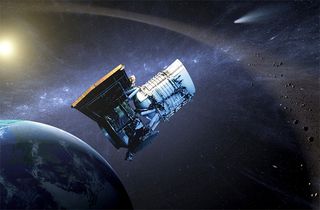
Former Microsoft chief technology officer Nathan Myhrvold is off base in his criticisms of an asteroid-studying NASA mission, space agency officials say.
Myhrvold — a polymath who co-founded the patent-monetization company Intellectual Ventures and also authored the six-volume, 2,400-page cookbook "Modernist Cuisine" — recently submitted a paper to the journal Icarus that found fault with the way NASA scientists have analyzed asteroid data gathered by the agency's Wide-Field Infrared Survey Explorer (WISE) spacecraft during the "NEOWISE" phase of its mission.
In the paper, Myhrvold argued, among other things, that the models NASA researchers have used to estimate asteroid size from WISE observations fail to take into account key principles of radiation absorption and emission. As a result, these size estimates are far less reliable than NASA has claimed, Myhrvold wrote. [Photos: Asteroids in Deep Space]
"The bad news is it's all basically wrong," he told the New York Times. "Unfortunately for a lot of it, it’s never going to be as accurate as they had hoped."
But NASA posted a rebuttal online Wednesday (May 25) expressing faith in the NEOWISE analyses and noting that Myhrvold's paper has yet to be peer-reviewed.
"Examination of the paper by members of the science community studying near-Earth objects has found several fundamental errors in Myhrvold's approach and analysis — mistakes that an independent peer-review process is designed to catch," NASA officials wrote in the statement.
"The errors in the paper lead to results that are easily refuted, such as sizes for well-known asteroids that are significantly larger or smaller than their already-verified sizes," they added. "While critique and re-examination of published results are essential to the scientific process, it is important that any paper undergo peer review by an independent journal before it can be seriously considered. This completes a necessary step to ensure science results are independently validated, reproducible and of value to the science community."
Get the Space.com Newsletter
Breaking space news, the latest updates on rocket launches, skywatching events and more!
The NEOWISE studies have been peer-reviewed, NASA officials added.
"NASA is confident that the processes and analyses performed by the NEOWISE team are valid and verified and stands by its data and scientific findings," they wrote.
The WISE spacecraft launched in December 2009 to perform a survey of the entire sky. In October 2010, the satellite embarked on the four-month NEOWISE program, during which WISE concentrated on studying near-Earth objects (hence the name).
WISE went into hibernation in February 2011 but was pressed back into service in September 2013, to hunt for asteroids and comets that could pose a threat to Earth.
Follow Mike Wall on Twitter @michaeldwall and Google+. Follow us @Spacedotcom, Facebook or Google+. Originally published on Space.com.
Join our Space Forums to keep talking space on the latest missions, night sky and more! And if you have a news tip, correction or comment, let us know at: community@space.com.

Michael Wall is a Senior Space Writer with Space.com and joined the team in 2010. He primarily covers exoplanets, spaceflight and military space, but has been known to dabble in the space art beat. His book about the search for alien life, "Out There," was published on Nov. 13, 2018. Before becoming a science writer, Michael worked as a herpetologist and wildlife biologist. He has a Ph.D. in evolutionary biology from the University of Sydney, Australia, a bachelor's degree from the University of Arizona, and a graduate certificate in science writing from the University of California, Santa Cruz. To find out what his latest project is, you can follow Michael on Twitter.
